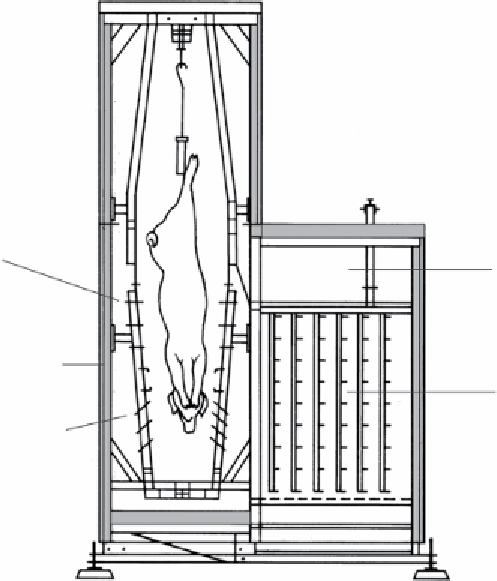Agriculture Reference
In-Depth Information
Distribution
nozzles
Channel for recirculated air
80 mm stainless steel
insulating elements
Humidifying zone
Circulation chamber
Figure 3.7
Vertical scalding of pigs showing, cross section of humidifying chamber, channel for recirculated air and humidifying zone
(by courtesy of SFK AmbA, Copenhagen, Denmark).
also be given to the capacity of each chamber to permit
optimal energy use and the implementation of an effec-
tive cleaning schedule.
In addition, offal on trays and A-frames can be chilled
in the same chill as the carcases. However, boxed meat
may not be stored in the same chill as exposed meat, so if
the intention is to package and store the offal prior to
dispatch, a separate chill will be required.
The carcases must be hung in such a way as to allow
free movement of cold air around them; rail spacing
should be 0.9 m for beef, 0.7 m for pigs and 0.5 m for
lambs. Theoretically, the minimum space between car-
cases on rails should be 0.3-0.4 m. However, pig carcases
in particular may be packed much tighter in the chill,
often touching, without significant 'hot spots' being sub-
sequently detected.
The positioning of the chiller unit within each chill
room is important to ensure efficient operation and
hygienic operation. Poor positioning of the unit with, for
example, the steel beams supporting the rail system
interfering with airflow or drip water or condensate fall-
ing onto carcases, particularly during defrosting cycles,
should be avoided. The effectiveness of the unit's system
to remove condensate from the evaporator via a drip tray
and pipes is important and usually requires these to be
well insulated and may incorporate a heater.
It is essential to record temperatures in order to con-
trol the chilling process, preferably on a continuous basis
using charts or computer-generated records. The record-
ing of relative humidity is also of value as is the occa-
sional checking of air speed.
Internal finishes of chills should be durable and
impervious, with good insulation and floor drainage.
Areas of walls where contact with carcases may occur,
for example, on loading, should be protected with stain-
less steel or plastic sheeting.
It is vital that chill and freezer doors be close fitting
and that they be provided with an internal opening
device to avoid personnel being closed in the rooms.
Detained meat room
Carcases detained for further examination should be
routed by a special rail to the
detained meat room
, which
should be located adjacent to the main slaughterhall
inspection points in order to achieve close liaison over
disease findings. All parts of the carcase must be
identifiable pending the final decisions. From this
detained meat room, the overhead rail must reconnect
with the main slaughter line for direction of carcases
either to the chill rooms or to the condemned meat
room. It is important that there should be ample space
for the examination of carcases which, being hot at this

